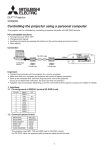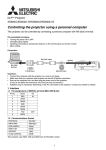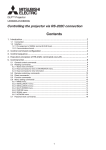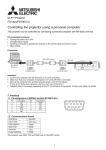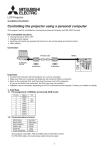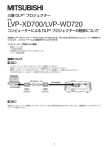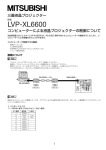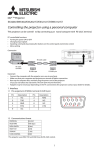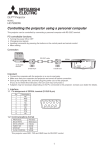Download Mitsubishi XL7000U User manual
Transcript
LCD Projector XL7100U Controlling the projector via RS-232C connection Contents 1. Introduction............................................................................................................. 2 1.1 Connection................................................................................................................................ 2 1.2 Interface.................................................................................................................................... 2 1.2.1 Pin assignment of SERIAL terminal (D-SUB 9-pin)............................................................................... 2 1.2.2 Communications format....................................................................................................................... 2 2. 3. 4. 5. Control command configuration............................................................................. 3 Control sequence.................................................................................................... 3 Execution procedure of RS-232C commands via LAN........................................... 6 Command list.......................................................................................................... 7 5.1 General control commands....................................................................................................... 7 5.2 Reading commands.................................................................................................................. 7 5.2.1 Status read commands......................................................................................................................... 7 5.2.2 Read commands for items in INFORMATION menu............................................................................. 7 5.2.3 Read commands for other information................................................................................................. 8 5.3 5.4 5.5 5.6 Remote control key commands................................................................................................ 9 Direct commands.................................................................................................................... 10 Function commands............................................................................................................... 10 Menu setting commands........................................................................................................ 11 5.6.1 5.6.2 5.6.3 5.6.4 5.6.5 IMAGE menu....................................................................................................................................... 11 INSTALLATION menu.......................................................................................................................... 11 FEATURE menu................................................................................................................................... 12 SIGNAL menu..................................................................................................................................... 12 NETWORK menu................................................................................................................................ 13 5.7 Password lock commands...................................................................................................... 14 1 1. Introduction This projector is controllable by a personal computer with RS-232C terminal. PC-controllable functions: • • • • Turning the power ON or OFF Changing input signals Inputting commands by pressing the buttons on the control panel and remote control Menu setting [Compatibility with the former models] To use the RS-232C commands designed for the former models of Mitsubishi projector, by inputting “00COMMAND0”, the projector responds in the same way as the former models. (No NAK is returned. For NAK response, see page 4.) (For the recommended procedure to use the former command systems, see “Controlling the projector using a personal computer” for FL7000U.) ITEM Character COMMAND Changing the RS-232C command system Function ASCII code 43h 4Fh 4Dh 4Dh 41h 4Eh 44h Data 0 (Former command system), 1 (New command system) 1.1 Connection Important: • Make sure to connect one computer to one projector. • Make sure that your computer and projector are turned off before connection. • Boot up the computer first, and then plug the power cord of the projector. (If you do not follow this instruction, the COM port may not function.) • Adapters may be necessary depending on the PC connected to this projector. Contact your dealer for details. To RS-232C terminal RS-232C crossover cable D-SUB 9-pin To SERIAL terminal D-SUB 9-pin 1.2 Interface 1.2.1 Pin assignment of SERIAL terminal (D-SUB 9-pin) Pin No. 1 2 3 4 5 6 7 8 9 Name OPEN RXD TXD OPEN GND OPEN OPEN OPEN OPEN I/O IN OUT 1.2.2 Communications format PROTOCOL BAUD RATE DATA LENGTH PARITY BIT STOP BIT FLOW CONTROL RS-232C 9600 [bps] 8 [bits] NONE 1 [bit] NONE This projector uses RXD, TXD and GND lines for RS-232C control. For RS-232C cable, the supplied cable (crossover cable) should be used. 2 2.Control command configuration The command consists of the address code, function code, data code, ACK/NAK, and end code. The length of the command varies among the functions. ASCII code Character Address code ‘30h’ ‘30h’ 00 Function code Function Function Data code Data Data ACK/NAK ‘3Ah’ ‘4Eh’ :N End code ‘0Dh’ [Address code] Fixed to 00. (‘30h’ ‘30h’ in the ASCII code) [Function code] Code unique to each control operation. [Data code]Data (value) unique to each control operation (Not always indicated.) [ACK/NAK]Code indicating the NAK return as described below Fixed to :N (‘3Ah’ ‘4Eh’ in the ASCII code. Not added to ACK.) [End code]Fixed to . (‘0Dh’ in the ASCII code) 3.Control sequence Computer Projector 1 1 2 3 2 Sequence Send the command from the personal computer to the projector. After receiving the end code, the projector sends the return command. 4 3 4 The personal computer checks the return command and confirms if the sent command has been received or not. Use the check command to see if the projector has executed the command. 3 Note If the projector does not receive commands normally, that is, if the projector is not connected physically or unable to receive commands, it does not send out a return command. When the received command cannot be executed, NAK is returned (as described below). This projector sends various codes including the return code. During the control sequence by RS-232C, reject other codes on the personal computer. • NAK return In the following cases, the projector returns the command with “:N” added. (1)Though the command sent from the computer is received by the projector successfully, it cannot be executed because the projector is in the operation prohibition state. (2)The data length of the sent command is incorrect or the command is invalid. (3)The signal length of the command is 48 bytes or longer. • When a command is sent out during the following operations, it may not be executed. (1)During signal switching (2)In the process of the auto position (3)After the power is turned on. After the power is turned on, no command is received until the image is displayed. (Usually, it takes about 20 seconds. However, when the lamp illumination takes time, more time will be required accordingly.) In this case, the projector returns the received command with NAK added. • The return command is sent out within 1 second. In some cases, the response time takes longer (about 3 seconds). • When sending commands successively, wait to receive the return command of the current command before sending a next command. • The projector may not receive a command when the splash screen is being displayed immediately after turning on the power. Use command “00r10” to cancel the splash screen. • While using the LAN terminals, the LAN functions take precedence. • For the LAN terminals, the same commands as those for connecting with the TCP/IP (port number 63007) are available. Note, however, that the response becomes slightly slower than when using the RS-232C terminals. For the use of LAN terminals, refer to “4. Execution procedure of RS-232C commands via LAN”. • When the NAK isn’t returned, check the RS-232C command system (00COMMAND). [Example 1] Turning ON the power. (Values enclosed in quotation marks are ASCII codes.): Command sent from the PC Status code returned from the projector ‘30’ ‘30’ ‘21’ ‘0D’ 00! Description Command for POWER ON ‘30’ ‘30’ ‘21’ ‘0D’ 00! Command receipt confirmation (Command echo back) [Example 2] Selecting VIDEO as the input signal during auto positioning (Values enclosed in quotation marks are ASCII codes.): Command sent from the PC Status code returned from the projector 30’ ‘30’ ‘5F’ ‘76’ ‘31’ ‘0D’ 00_v1 ‘30’ ‘30’ ‘5F’ ‘76’ ‘31’ ‘3A’ ‘4E’ ‘0D’ 00_v1:N Description (During auto positioning) Command for selecting VIDEO as the input signal is sent out. The command is received by the projector but cannot be executed. (NAK return) • The flowchart on the next page shows the recommended operating sequence for your reference to create a program. 4 [RS-232C control flowchart] START Sending out command No NAK returned No response for 3 seconds or longer Awaiting response from projector NAK returned Command is sent successfully. Command is executed successfully. Checking execution of command (sending out check command) Command is sent successfully. Command execution fails. Check the following. • Check that the function code is correct. • Check that the data code is correct. • Check that the projector is able to issue the return command. → Check the projector’s operation using the 00vST command. Note: In the following cases, NAK is returned even when the projector is in normal condition. • Immediately after the power is turned on (For status read commands) approximately for 20 seconds (For other commands) approximately for 1 minute • During input switching • During auto positioning • During password lock NG OK END Command sending fails. Check the following. • Check that the command begins with “00”. • The projector is not supplied with AC power. → Check that AC power cord is connected. → Turn on the power. (Turn on the circuit breaker.) • Not connected with the projector. → Check that the RS-232C cable is connected. → Check the RS-232C cable for electrical discontinuity. [Method of checking state of projector] Sending “00vST” To normal operation 0–3 Checking response to “00vST” 6 Enter password. Send out “00PASS****.” 4 Projector error Send out “00vER” to check error details. Recover from error state. 5 Projector is functioning. Use “00FNCOFF” to cancel the current function. 5 4. Execution procedure of RS-232C commands via LAN • When you use the LAN function, set the STANDBY MODE to STANDARD or LAN. • When you execute RS-232C commands via LAN, check that the CONTROL SYSTEM in the NETWORK menu is set to STANDARD. • You can change the certification password using the NETWORK PASSWORD in the NETWORK menu. The default password is “admin.” • You can skip the certification process by setting the NETWORK CERTIFICATION in the NETWORK menu to OFF. When you skip the certification process, Steps 2 to 4 described below can be skipped and you can send RS-232C commands without adding a certification data. Example: Sending the PON command (00!) while the NETWORK CERTIFICATION is set to OFF 00! For the procedure to set the menu, refer to the User Manual supplied with the projector. To execute the RS-232C command via LAN while the NETWORK CERTIFICATION is set to ON, a 32-byte connection certification data must be added before the RS-232C command. To create a 32-byte certification data, following information and procedure are required. • Random character string for creating the certification data that is acquired from the projector (8 characters) • Network password of the projector (1 to 32 characters) • MD5 hash calculation • Based on the above, the execution procedures to connect to the projector and send the RS-232C commands while the NETWORK CERTIFICATION is set to ON are described below. 1. Connect to Port 63007 of the projector from the PC as a TCP/IP client. 2. After completing the connection, send the acquisition request for the certification data (“$AK ”) (ASCII code: 24 41 4B 0D) from the PC to the projector. 3. Acquire “$AK******** ” on the PC as the response of the request sent in Step 2. (********: Random character string for creating the certification data) 4. Create the certification data on the PC. • Create the key of the certification data by linking the data acquired in Step 3 with the network character string. For example, when the random character string is 12345678 and the password is ABCD, the key of the certification data is 12345678ABCD (character string in ASCII code). • Run MD5 hash on the key of the certification data. • Create the certification data by converting the hash-calculated 16-byte data into the ASCII code character string. Example: Calculation result: [4f][3c][5d][a1][7b][4f][b5][ed][2c][99][4e][bb][f6][57][67][54] (hexadecimal numeral) Certification data: 4f 3c 5d a1 7b 4f b5 ed 2c 99 4e bb f6 57 67 54 (character string in ASCII code) 5. Send the RS-232C command with the certification data from the PC to the projector. Example: To send the PON command (00! ) using the certification data created in Step 4: 4f3c5da17b4fb5ed2c994ebbf657675400! 6. Receive the response from the projector on the PC. Response data has the following patterns. Normal: 00! (Parameter is added depending on the command.) Error in the certification data: PRV=ERRA Command error: 00!:N PC Projector 1. Connection 2. Acquisition request of the certification data 3. Receiving of the certification data 4. Creation of the certification data 5. Sending of the RS-232C command 6. Receiving of the response data 6 5. Command list 5.1 General control commands The general control commands are used for the basic operation setting of this projector. They may not be executed while the signals are changed. The general control commands have no data codes. (When the commands for input select are sent while the splash screen is being displayed, the splash screen is only canceled.) ITEM POWER ON POWER OFF INPUT COMPUTER 1 INPUT COMPUTER 2 INPUT HDMI INPUT DVI INPUT VIDEO INPUT S-VIDEO [Example] Function Character ASCII code ! 21h " 22h _r1 5Fh 72h 31h _r2 5Fh 72h 32h _d1 5Fh 64h 31h _d2 5Fh 64h 32h _v1 5Fh 76h 31h _v2 5Fh 76h 32h Note This command is invalid for 150 seconds after the power is turned off. This command is invalid for 1 minute after the power is turned on. This command is not received during stand-by and BLANK. This command is not received during stand-by and BLANK. This command is not received during stand-by and BLANK. This command is not received during stand-by and BLANK. This command is not received during stand-by and BLANK. This command is not received during stand-by and BLANK. When setting the input signal to COMPUTER 1. (Values enclosed in quotation marks are ASCII codes.): Status code returned from the projector Command sent from the PC, etc. Description ‘30’ ‘30’ ‘5F’ ‘72’ ‘31’ ‘0D’ 00_r1 Command for setting the input signal to COMPUTER 1 Command receipt confirmation (Command echo back) ‘30’ ‘30’ ‘5F’ ‘72’ ‘31’ ‘0D’ 00_r1 5.2 Reading commands 5.2.1 Status read commands The projector’s operating status, such as POWER-ON/OFF and the currently selected input terminal, etc. can be monitored. ITEM POWER Function Character vP INPUT vI P-ON/OFF ENABLED/DISABLED SIGNAL INPUT vPK vSM Data (Receive) Character ASCII 1 31h 0 30h r1 72h 31h r2 72h 32h d1 64h 31h d2 64h 32h v1 76h 31h v2 76h 32h ASCII 76h 50h 76h 49h 76h 50h 4Bh 76h 53h 4Dh 0 30h 1 31h 0 1 30h 31h Status POWER ON POWER OFF INPUT COMPUTER 1 INPUT COMPUTER 2 INPUT HDMI INPUT DVI INPUT VIDEO INPUT S-VIDEO POWER ON/OFF DISABLED POWER ON/OFF ENABLED NO SIGNAL SUPPLIED SIGNAL SUPPLIED 5.2.2 Read commands for items in INFORMATION menu Use the following commands to obtain the values of the items in the INFORMATION menu. ITEM LAMP TIME (LOW) SERIAL NUMBER RESOLUTION VERTICAL FREQUENCY HORIZONTAL FREQUENCY SYNC. TYPE Character vLE vS/N vRESO vVFREQ vHFREQ vSYNCT Function ASCII code 76h 4Ch 45h 76h 53h 2Fh 4Eh 76h 52h 45h 53h 4Fh 76h 56h 46h 52h 45h 51h 76h 48h 46h 52h 45h 51h 76h 53h 59h 4Eh 43h 54h Data (Receive) hhhhmm ******* (within 7 characters) HHHHxVVVV ***.** ***.** 0 (NO SIGNAL), 1 (Invalid), 3 (3wire), 4 (4wire), 5 (5wire), 6 (SCART) “hhhh” and “mm” represent hours and minutes respectively. “HHHH” and “VVVV” represent the horizontal and vertical resolutions respectively. “***.**” represents the vertical frequency (in Hz) or the horizontal frequency (in kHz). 7 5.2.3 Read commands for other information Use the following commands to obtain other information. Model name Input source Number of remaining filters Reading of filter usage time Projector status Character vMDL vSOUCE vFLTS vFLTT vST Function ASCII code 76h 4Dh 44h 4Ch 76h 53h 4Fh 55h 43h 45h 76h 46h 4Ch 54h 53h 76h 46h 4Ch 54h 54h 76h 53h 54h Error status vER 76h 45h 52h ITEM Data (Receive) **************** (within 16 characters) r1 r2 v1 v2 d1 d2 00 to 09 0000 to 9999 0(Stand-by mode), 1(Within 1 minute after POWER-ON (warm-up mode)), 2(POWER-ON mode (including state of warning)), 3(Cooling mode), 4(Abnormal state (including shutdown due to an error)), 5(State of functioning (menu display, dialog display, BLANK, SPLIT, MAGNIFY, FREEZE, etc.)), 6(Awaiting password entry) Reading of the error status data (3 digits, hexadecimal numbers, total 9 bits) (MSB) xb1, xb2... xb8, xb9, 0, 0, 0 (LSB) xb1(800): Fan error xb2(400): Lamp error (The lamp goes out or does not light.) xb3(200): Lamp warning 1 (The lamp life has expired.) xb4(100): Lamp warning 2 (The lamp life is expiring.) xb5(080): Temperature error xb6(040): The temperature warning is being indicated. xb7(020): Lamp cover open error xb8(010): Filter/filter cover open error xb9(008): States of other component abnormality When only one error occurs, value shown in parentheses is returned. When multiple errors occur at the same time, the bits of all the occurred error are set. Example) C00: When fan error and lamp error occur at the same time 180: When lamp warning 2 and temperature error occur at the same time The PC sends the command without attaching the data code to it. On the other hand, the projector attaches to the received command its current operating status as the data code and send it back to the PC. [Example] When checking the currently selected input terminal (when the INPUT VIDEO is being selected). (Values enclosed in quotation marks are ASCII codes.): Command sent from the PC, etc. Status code returned from the projector ‘30’ ‘30’ ‘76’ ‘49’ ‘0D’ 00vl ‘30’ ‘30’ ‘76’ ‘49’ ‘76’ ‘31’ ‘0D’ 00vlv1 8 Description Command for checking the input terminal Check result (VIDEO) 5.3 Remote control key commands (Not executable in stand-by mode. When the remote control key commands are sent while the splash screen is being displayed, the splash screen is only canceled.) The remote control key commands allow the computer to control the projector in the same way as by the remote control. (Some operations cannot be controlled.) The remote control key commands have no data codes. Button’s name on remote control +/VOLUME -/VOLUME ZOOM/FOCUS LENS SHIFT GEOMETRY MAGNIFY PinP/SPLIT (PinP only) BLANK MENU ENTER AUTO POSITION FREEZE ASPECT CE TEST PATTERN SUPER RESOLUTION 1 (numeric keypad) 2 (numeric keypad) 3 (numeric keypad) 4 (numeric keypad) 5 (numeric keypad) 6 (numeric keypad) 7 (numeric keypad) 8 (numeric keypad) 9 (numeric keypad) 0 (numeric keypad) [Example] Character r06 r07 r0f r47 r43 r02 r04 ra6 r53 r2b r4f r59 r54 r10 r09 ra4 re2 re7 r50 r96 r49 r4a r4b r4c r4d r4e r88 r58 r89 r48 Function ASCII code 72h 30h 36h 72h 30h 37h 72h 30h 66h 72h 34h 37h 72h 34h 33h 72h 30h 32h 72h 30h 34h 72h 61h 36h 72h 35h 33h 72h 32h 62h 72h 34h 66h 72h 35h 39h 72h 35h 34h 72h 31h 30h 72h 30h 39h 72h 61h 34h 72h 65h 32h 72h 65h 37h 72h 35h 30h 72h 39h 36h 72h 34h 39h 72h 34h 61h 72h 34h 62h 72h 34h 63h 72h 34h 64h 72h 34h 65h 72h 38h 38h 72h 35h 38h 72h 38h 39h 72h 34h 38h When displaying the MENU selection bar. (Values enclosed in quotation marks are ASCII codes.): Command sent from the PC, etc. Status code returned from the projector ‘30’ ‘30’ ‘72’ ‘35’ ‘34’ ‘0D’ 00r54 ‘30’ ‘30’ ‘72’ ‘35’ ‘34’ ‘0D’ 00r54 9 Description Command operating the same as the MENU button Command receipt confirmation (Command echo back) 5.4 Direct commands (Not executable in stand-by mode. Possible only to read during BLANK.) The direct commands are used to numerically adjust the geometrical correction and volume. When the computer sends the command without adding the setting value, the projector returns the received command with the current setting value added as a data code. ITEM Character KS KEYSTONE (vertical) Function ASCII code 4Bh 53h Data ±40 With CURVED-adjustment : ±10 ±25 With CURVED-adjustment : ±10 KEYSTONE (horizontal) KSH 4Bh 53h 48H KEYSTONE reset CORNERSTONE LOWER RIGHT (vertical) CORNERSTONE LOWER RIGHT (horizontal) CORNERSTONE LOWER LEFT (vertical) CORNERSTONE LOWER LEFT (horizontal) CORNERSTONE UPPER RIGHT (vertical) CORNERSTONE UPPER RIGHT (horizontal) CORNERSTONE UPPER LEFT (vertical) CORNERSTONE UPPER LEFT (horizontal) CORNERSTONE reset HORIZ. CURVED ARC KSRST CNLRV 4Bh 53h 52h 53h 54h 43h 4Eh 4Ch 52h 56h ±50 CNLRH 43h 4Eh 4Ch 52h 48h ±50 CNLLV 43h 4Eh 4Ch 4Ch 56h ±50 CNLLH 43h 4Eh 4Ch 4Ch 48h ±50 CNURV 43h 4Eh 55h 52h 56h ±50 CNURH 43h 4Eh 55h 52h 48h ±50 CNULV 43h 4Eh 55h 4Ch 56h ±50 CNULH 43h 4Eh 55h 4Ch 48h ±50 CKSRST CVAH 43h 4Bh 53h 52h 53h 54h 43h 56h 41h 48h VERT. CURVED ARC CVAV 43h 56h 41h 56h HORIZ. CURVED ORIGIN (vertical) HORIZ. CURVED ORIGIN (horizontal) VERT. CURVED ORIGIN (vertical) VERT. CURVED ORIGIN (horizontal) CURVED reset VOLUME CVHOV CVHOH 43h 56h 48h 4Fh 56h 43h 56h 48h 4Fh 48h CVVOV CVVOH CVRST VL 43h 43h 43h 56h 56h 56h 4Fh 56h 56h 56h 4Fh 48h 56h 52h 53h 54h 4Ch ±50 With KEYSTONE-adjustment : ±15 ±50 With KEYSTONE-adjustment : ±15 ±10 ±10 ±10 ±10 00 to 31 How to set the value Use the character or ASCII code as shown below to set the value. Character + 0 1 2 3 4 5 6 7 8 9 ASCII code ‘2Bh’ ‘2Dh’ ‘30h’ ‘31h’ ‘32h’ ‘33h’ ‘34h’ ‘35h’ ‘36h’ ‘37h’ ‘38h’ ‘39h’ 5.5 Function commands (Not executable in stand-by mode. When these commands are sent while the splash screen is being displayed, the splash screen is canceled.) ITEM BLANK PinP MAGNIFY FREEZE Function canceling Character MUTE PiP MGNFY FRZ FNCOFF Function ASCII code 4Dh 55h 54h 45h 50h 69h 50h 4Dh 47h 4Eh 46h 59h 46h 52h 5Ah 46h 4Eh 43h 4Fh 46h 46h 10 Data 0 (OFF), 1 (ON) 0 (OFF), 1 (ON) 0 (OFF), 1 (ON) 0 (OFF), 1 (ON) 5.6 Menu setting commands (Not executable in stand-by mode except some commands. Possible only to read during BLANK except some commands.) The menu setting commands are used for the menu setting of this projector. If the personal computer sends the command without attaching the data code, the projector attaches to the received command its current setting value as the data code and send it back to the PC. 5.6.1 IMAGE menu ITEM COLOR ENHANCER Character CE Function ASCII code 43h 45h Data COLOR ENHANCERUSER-GAMMA MODE SUPER RESOLUTION SUPER RESOLUTIONLEVEL CONTRAST BRIGHTNESS NCM (MODE) NCM (R,G,B) NCM (Y,C,M) NCM (SATURATION) NCM (RGB-TINT) COLOR TEMP. COLOR TEMP.-USERCONTRAST COLOR TEMP.-USERBRIGHTNESS COLOR TINT SHARPNESS AUTO IRIS NOISE REDUCTION CTI INPUT LEVEL CEU1GS 43h 45h 55h 31h 47h 53h 0 (AUTO), 1 (PRESENTATION), 2 (STANDARD), 3 (THEATER), 4 (sRGB), 5 (USER), 6 (CLEAR BASE), 7 (BLUE BASE) 0 (DYNAMIC), 1 (NATURAL), 2 (DETAIL) DHD DHDLV 44h 48h 44h 44h 48h 44h 4Ch 56h 0 (OFF), 1 (ON) 1 to 5 PP QQ CMT MRGB MYCM MSAT MT A P 50h 51h 43h 4Dh 4Dh 4Dh 4Dh 41h 50h ±30 ±30 1 (VIDEO), 2 (COMPUTER), 3 (USER), 4 (OFF) ±30 ±30 ±30 (R+G+B) ±30 ±30 ±30 (Y+C+M) ±05 ±15 1 (STANDARD), 2 (HIGH), 3 (LOW), 4 (USER) ±30 ±30 ±30 (R, G, B) Q 51h ±30 ±30 ±30 (R, G, B) T S R IRIS NR CTI IPL 54h 53h 52h 49h 4Eh 43h 49h CLOSED CAPTION CC 43h 43h ±10 ±10 ±05 0 (OFF), 1 (ON) 0 (OFF), 1 (ON) 0 (OFF), 1 (ON) ±5, For DVI input: +0 (NORMAL), +1 (ENHANCED) For HDMI input: +0 (AUTO), +1 (NORMAL), +2 (ENHANCED) 0 (OFF), 1 (CC1), 2 (CC2) 50h 51h 4Dh 52h 59h 53h 54h 54h 47h 42h 43h 4Dh 41h 54h 52h 49h 53h 52h 54h 49h 50h 4Ch 5.6.2 INSTALLATION menu ITEM LAMP MODE STANDBY MODE AUTO POWER ON AUTO POWER OFF Character LM STBY APON APOF Function ASCII code 4Ch 4Dh 53h 54h 42h 59h 41h 50h 4Fh 4Eh 41h 50h 4Fh 46h SPLASH SCREEN BACK COLOR IMAGE REVERSE SS BB IR 53h 53h 42h 42h 49h 52h ZOOM/FOCUS LOCK LENS SHIFT LOCK LENS SHIFT RESET DVI LONG CABLE (MODE) DVI LONG CABLE (LEVEL) FZL LSL LSRST DVIC 46h 4Ch 4Ch 44h DVICLV 44h 56h 49h 43h 4Ch 56h 5Ah 53h 53h 56h 4Ch 4Ch 52h 53h 54h 49h 43h 11 Data 0 (STANDARD), 1 (LOW) 0 (STANDARD), 1 (LOW), 2 (LAN) 0 (OFF), 1 (ON) 0 (OFF), 1 (5 min.), 2 (10 min.), 3 (15 min.), 4 (30 min.), 5 (60 min.), 6 (4 hours), 7 (8 hours) 0 (OFF), 1 (ON) 0 (BLACK), 1 (BLUE), 2 (IMAGE) 0 (OFF), 1 (MIRROR), 2 (INVERT), 3 (MIRROR INVERT) 0 (OFF), 1 (ON) 0 (OFF), 1 (ON) 0 (AUTO), 1 (MANUAL) 00 to 21 5.6.3 FEATURE menu ITEM ASPECT ASPECT-16:9-POSITION ASPECT-16:9-MODE PROJECTOR ID PASSWORD FUNCTION Character SC SCP SCM PID PSLOCK Function ASCII code 53h 43h 53h 43h 50h 53h 43h 4Dh 50h 49h 44h 50h 53h 4Ch 4Fh 43h 4Bh Data 0 (NORMAL), 1 (16:9), 2 (FULL) 0 (CENTER), 1 (UPPER), 2 (LOWER) 0 (ALL SIGNALS), 1 (VIDEO ONLY) 00 (ALL), 01 to 63 0**** (UNLOCK), 1**** (DISPLAY INPUT), 2**** (MENU ACCESS), 3**** (SPLASH ID SCREEN) **** is a 4 to 8-digit password comprised of any figures 1 to 4. 0 (Upper left), 1 (Lower right) 0 (VIDEO), 1 (AUTO), 2 (FILM) 0 (OFF), 1 (Every 500 hours), 2 (Every 750 hours), 3 (Every 1000 hours) MENU POSITION CINEMA MODE FILTER MENU -AUTO ROLL UP PERIOD FILTER MENU -MANUAL ROLL UP FILTER MENU -REMAINING FILTERS FILTER MENU -FILTER USAGE TIME FILTER MENU -FILTER RESET LANGUAGE MP CINE FLCP 4Dh 50h 43h 49h 4Eh 45h 46h 4Ch 43h 50h FLMC 46h 4Ch 4Dh 43h vFLTS 46h 4Ch 54h 53h 00 to 09 (number of times) vFLTT 46h 4Ch 54h 54h 0000 to 9999 (hours) TRSTFL 54h 52h 53h 54h 46h 4Ch LG 4Ch 47h HIGH ALTITUDE MODE VIDEO SIGNAL (VIDEO only) SET UP SCART INPUT LAMP WARNING HIDE OSD RESET ALL ALTI VS 41h 4Ch 54h 49h 56h 53h STU SRT LW HOSD RSTALL 53h 53h 4Ch 48h 52h Reset of the number of remaining filters and filter usage time 00 ( ), 01 (English), 02 (Español), 03 (Deutsch), 04 (Français), 05 (Italiano), 06 ( ), 07 ( ), 08 ( ), 09 (PORTUGUÊS), 11 (SVENSKA), 12 (POLSKI), 16 (Nederlands), 17 (Norsk), 18 ( ), 19 (Türkçe), 20 ( ภาษาไทย ), 21 (Bahasa Indonesia), 22 (Melayu), 23 ( ) 0 (STANDARD), 1 (HIGH ALTITUDE) 0 (AUTO), 1 (NTSC), 2 (PAL), 3 (SECAM), 4 (4.43NTSC), 5 (PAL-M), 6 (PAL-N), 7 (PAL-60) 0 (AUTO), 1 (OFF), 2 (3.75%), 3 (7.5%) 0 (OFF), 1 (ON) 0 (STANDARD), 1 (SHORT TERM) 0 (OFF), 1 (ON) 54h 52h 57h 4Fh 53h 55h 54h 53h 44h 54h 41h 4Ch 4Ch 5.6.4 SIGNAL menu ITEM MEMORY CALL HORIZ.POSITION VERT. POSITION FINE SYNC. TRACKING COMPUTER INPUT OVER SCAN HOLD HOLD BEGIN HOLD END CLAMP POSITION CLAMP WIDTH VERT. SYNC. LPF SHUTTER(U) SHUTTER(L) SHUTTER(LS) SHUTTER(RS) Character MMC HP VP FN TRK CIN VOS HLD HLB HLE CLP CLW VSC LPF SHU SHL SHLS SHRS Function ASCII code 4Dh 4Dh 43h 48h 50h 56h 50h 46h 4Eh 54h 52h 4Bh 43h 49h 4Eh 56h 4Fh 53h 48h 4Ch 44h 48h 4Ch 42h 48h 4Ch 45h 43h 4Ch 50h 43h 4Ch 57h 56h 53h 43h 4Ch 50h 46h 53h 48h 55h 53h 48h 4Ch 53h 48h 4Ch 53h 53h 48h 52h 53h *1)Setting range differs depending on the input signals. 12 Data 0 (AUTO), 1 (MEMORY1), 2 (MEMORY2) + (increment), - (decrement)*1 + (increment), - (decrement)*1 00 to 31 + (increment), - (decrement)*1 0 (RGB), 1 (YCBCR/YPBPR), 2 (AUTO) 00 (90%) to 10 (100%) 0 (OFF), 1 (ON) 00–99 00–99 001–255 01–63 0 (AUTO), 1 (OFF) 0 (OFF), 1 (ON) 00 to 38 00 to 38 00 to 63 00 to 63 5.6.5 NETWORK menu ITEM PROJECTOR NAME NETWORK RESTART Character NAME NRCN Function ASCII code 4Eh 41h 4Dh 45h 4Eh 52h 43h 4Eh Data Up to 15 single-byte alphanumeric characters • Some commands are not executed depending on the input signal. The operational restrictions same as those on the menu setting are applied. Refer to “Menu operation” in the User Manual for more details. How to set the value Use the character or ASCII code as shown below to set the value. Character + 0 1 2 3 4 5 6 7 8 9 ASCII code ‘2Bh’ ‘2Dh’ ‘30h’ ‘31h’ ‘32h’ ‘33h’ ‘34h’ ‘35h’ ‘36h’ ‘37h’ ‘38h’ ‘39h’ [Example 1] When setting the AUTO POWER ON to ON. (Values enclosed in quotation marks are ASCII codes.): Command sent from the PC, etc. Status code returned from the projector ‘30’ ‘30’ ‘41’ ‘50’ ‘4F’ ‘4E’ ‘31’ ‘0D’ 00APON1 ‘30’ ‘30’ ‘41’ ‘50’ ‘4F’ ‘4E’ ‘31’ ‘0D’ 00APON1 Description Command for setting the AUTO POWER ON to ON Command receipt confirmation (Command echo back) [Example 2] When setting the CONTRAST R of the COLOR TEMP.-USER to +10, the CONTRAST G to 0, and the CONTRAST B to -5. (Values enclosed in quotation marks are ASCII codes.): Command sent from the PC, etc. Status code returned from the projector ‘30’ ‘30’ ‘50’ ‘2B’ ‘31’ ‘30’ ‘2B’ ‘30’ ‘30’ ‘2D’ ‘30’ ‘35’ ‘0D’ 00P+10+00-05 ‘30’ ‘30’ ‘50’ ‘2B’ ‘31’ ‘30’ ‘2B’ ‘30’ ‘30’ ‘2D’ ‘30’ ‘35’ ‘0D’ 00P+10+00-05 Description Command for setting the picture control Command receipt confirmation (Command echo back) [Example 3] When checking the TINT setting (when the TINT is set to +10). (Values enclosed in quotation marks are ASCII codes.): Command sent from the PC, etc. Status code returned from the projector ‘30’ ‘30’ ‘53’ ‘0D’ 00S ‘30’ ‘30’ ‘53’ ‘2B’ ‘31’ ‘30’ ‘0D’ 00S+10 Description Command for checking the TINT setting Check result (+10) [Example 4] When setting the GAMMA MODE of the COLOR ENHANCER-USER to DETAIL. (Values enclosed in quotation marks are ASCII codes.): Command sent from the PC, etc. Status code returned from the projector ‘30’ ‘30’ ‘43’ ‘45’ ‘55’ ‘31’ ‘47’ ‘53’ ‘32’ ‘0D’ 00CEU1GS2 ‘30’ ‘30’ ‘43’ ‘45’ ‘55’ ‘31’ ‘47’ ‘53’ ‘32’ ‘0D’ 00CEU1GS2 13 Description Command for setting the picture control Command receipt confirmation (Command echo back) 5.7 Password lock commands The password lock commands control the password lock. The password lock enabling or disabling command is sent with a 4 to 8-digit password comprised of any figures 1 to 4 added to the end of the data code. When the password lock is enabled or disabled successfully, the projector sends a return command comprising the data code, password, and “1” at the end. When enabling or disabling the password lock fails, it sends a return command with “0” at the end. There is no reconfirmation of the password. The password input command is for enabling projection of image when password lock has been set to DISPLAY INPUT. The password input command is sent with a 4 to 8-digit password comprised of any figures 1 to 4 at the end. ITEM Password lock enabling/ disabling Password input Character PSLOCK PASS Function ASCII code 50h 53h 4Ch 4Fh 43h 4Bh 50h 41h 53h 53h Data 0**** (Disabling), 1**** (DISPLAY INPUT), 2**** (MENU ACCESS), 3**** (SPLASH ID SCREEN) **** **** is a 4 to 8-digit password comprised of any figures 1 to 4. [Example] When enabling the password lock of DISPLAY INPUT (in the case that the password is 123412). (Values enclosed in quotation marks are ASCII codes.): Command sent from the PC, etc. Status code returned from the projector ‘30’ ‘30’ ‘50’ ‘53’ ‘4C’ ‘4F’ ‘43’ ‘4B’ ‘31’ ‘31’ ‘32’ ‘33’ ‘34’ ‘31’ ‘32’ ‘0D’ 00PSLOCK1123412 ‘30’ ‘30’ ‘50’ ‘53’ ‘4C’ ‘4F’ ‘43’ ‘4B’ ‘31’ ‘31’ ‘32’ ‘33’ ‘34’ ‘31’ ‘32’ ‘31’ ‘0D’ 00PSLOCK11234121 14 Description Command for enabling the password lock of DISPLAY INPUT Response informing that the projector succeeded in enabling the password lock of DISPLAY INPUT














